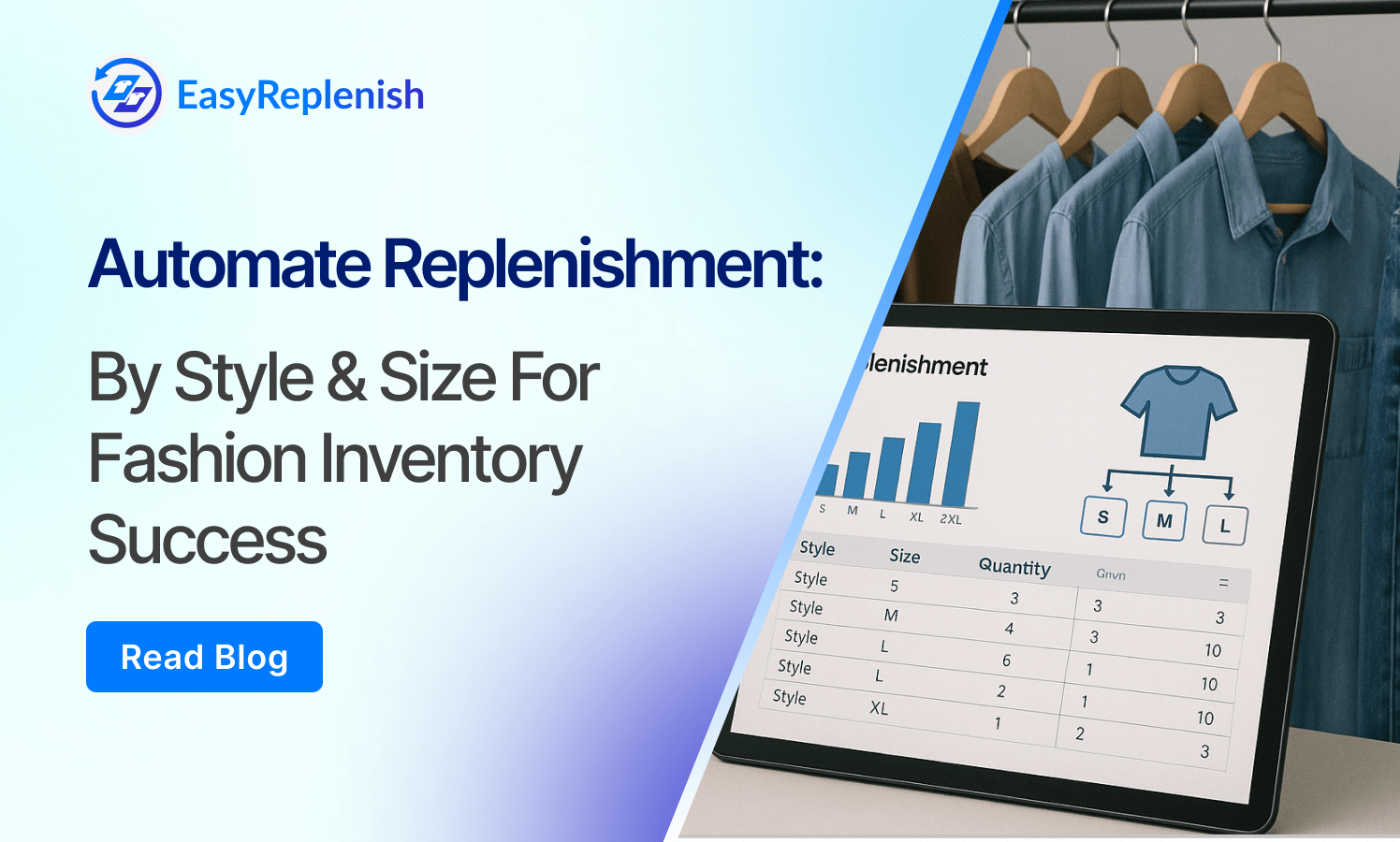Automate Replenishment by Style & Size for Fashion Inventory Success

Running out of your best-selling size or sitting on excess stock in unpopular styles is more than a logistical issue—it’s a profitability problem. In fashion, footwear, and multi-SKU retail, replenishment decisions made at the style level often miss what's happening where it matters most: at the size and color variant level.
As assortments grow, manual planning can’t keep up with the speed and granularity required to stay in stock on what sells and avoid piling inventory where it doesn’t. That’s where automated replenishment systems come in. These tools analyze demand patterns in real time, factor in sales velocity by size and style, and trigger reorders automatically—before problems surface.
This blog breaks down why replenishment across styles and sizes is uniquely complex, and how automation can help brands move from reactive fire-fighting to proactive inventory control.
Why Replenishment Across Styles & Sizes Is Challenging
Replenishment isn’t hard because businesses lack data—it’s hard because the volume, fragmentation, and behavior of the data make it nearly impossible to manage manually. Here’s why it becomes increasingly difficult as your catalog scales.
1. SKU Proliferation
In fashion and apparel, one style may multiply into 20–30 SKUs when you account for sizes, colors, and fits. Managing replenishment across hundreds of such combinations creates operational drag and increases error rates if done manually.
2. Size-Level Demand Is Uneven
It’s rare for all sizes of a given SKU to sell at the same pace. Size M might sell out in 2 weeks while XS and XL linger for months. Without automation, planners either overbuy across the board or under-serve top-selling sizes, resulting in both overstock and stockouts at once.
3. Channel Preferences Vary by Style/Size
Marketplace sales may trend toward smaller sizes due to regional preferences, while D2C might see higher conversions in larger sizes. Planning without channel-level segmentation leads to misplaced stock.
4. Lead Times Create Risk
When reordering based on static cycles, brands either wait too long to restock bestsellers or order too early without updated sales signals. This is especially problematic for fast-moving SKUs where missing a week means missing the trend window.
5. Manual Planning Doesn’t Scale
Replenishing 30 SKUs per month is manageable. Replenishing 300 isn’t—especially when demand signals shift across channels and variants. Excel-based workflows collapse under the weight of size-level complexity.
Brands that automate replenishment at the style-size level gain real-time visibility, improve sell-through, and reduce the financial drag of wrong inventory. In the next section, we’ll define what automated replenishment really means—and what sets advanced systems apart.
What Is Automated Replenishment?
Automated replenishment is the process of using data-driven systems to maintain optimal stock levels—triggering reorders based on actual demand, sales velocity, and supply conditions without manual intervention. Instead of relying on static reorder points or fixed replenishment cycles, automated systems continuously monitor inventory performance and suggest or place POs at the SKU level.
At its core, automated replenishment replaces guesswork with logic. These systems factor in:
- Sales velocity at the style and size level
- Lead times from each supplier or warehouse
- Channel-wise sell-through rates
- Current stock levels, in-transit units, and pending POs
- Forecasted demand based on seasonality, trends, and promotions
1. Rule-Based vs AI-Driven Replenishment
There are two broad categories of automation:
- Rule-Based Systems use predefined thresholds (like “reorder when stock falls below 20 units”) but don’t adapt dynamically to demand spikes or delays. They’re useful for predictable SKUs but often miss emerging trends or fail to adjust quickly.
- AI-Driven Systems analyze real-time signals—sales trends, out-of-stock patterns, early demand surges—and make granular, predictive decisions across style, size, and color combinations. These systems continuously learn and improve over time, helping brands avoid both stockouts and overstock.
2. Why It Matters for Style & Size Replenishment
In categories like apparel or footwear, where SKUs multiply fast and size-wise sell-through can make or break margins, manual or delayed replenishment leads to mismatches. Automation helps brands move from "reactive restocking" to "intelligent availability"—ensuring top-selling sizes are always in stock, while slow movers don’t clog up space and cash flow.
How Automation Solves Style & Size-Level Replenishment
Inventory complexity in fashion retail isn’t just about the number of SKUs—it’s about the speed at which demand shifts across styles, sizes, colors, and sales channels. Automated replenishment systems use machine learning and attribute-based logic to manage these layers of complexity and ensure that the right product, in the right size, is always in the right place.
1. Style-Level Planning: Managing Assortment Width
Automation enables planners to identify which styles are consistently high-performing and which ones should be throttled. It does this by analyzing historical performance, return rates, and size-wise sell-through across launches. Instead of treating all styles equally, the system focuses reorder investment on what actually converts.
2. Size Curve Intelligence: Forecasting at the Size Level
A core feature of automation is the ability to forecast and replenish based on dynamic size curves—not fixed assumptions. It learns how demand breaks down across sizes for each style (e.g., 30% M, 25% L, 15% S), and adjusts reorder quantities to maintain optimal distribution, reducing stockouts in high-demand sizes and overstock in slow movers.
3. Color/Fabric Variant Logic: Attribute-Based Replenishment
Variants like color or fabric often behave differently even within the same style. An AI-driven system tracks the velocity of each variant and adapts replenishment accordingly—ensuring that bestselling combinations (e.g., black linen shirts in size M) are prioritized over less popular ones.
4. Multi-Channel Inventory Alignment
Automation doesn’t just look at aggregate demand—it segments it by channel. This allows the system to recommend different replenishment quantities for D2C vs marketplaces vs retail stores, based on channel-specific performance, returns, and customer behavior. The result: fewer misplaced units, better fulfillment rates, and lower inventory fragmentation.
5. Real-Time Replenishment Triggers
Unlike traditional systems that rely on weekly or monthly cycles, automated tools respond to real-time demand signals. As soon as a size or style approaches its reorder threshold—based on lead time, current stock, and forecasted sales—the system triggers a PO or replenishment task automatically. This ensures faster reaction times and fewer missed sales.
Real-World Example: Fashion Brand Automating 200+ SKUs
A mid-sized women’s fashion brand selling through its D2C site and two marketplaces was struggling with inconsistent availability across sizes and variants. Despite having strong sales velocity on core styles, the brand faced repeated stockouts in high-demand sizes like M and L—while sitting on excess stock in sizes XS and XL. Replenishment decisions were made manually every two weeks, often using outdated sell-through data and gut feel.
The Problem:
By Week 5 of their summer collection, 70% of best-selling variants were either out of stock or understocked on marketplaces, leading to fulfillment penalties and reduced visibility in search rankings. At the same time, the brand was holding 4,000+ units of unsold low-demand sizes in key styles, tying up over ₹28 lakh (~$35,000) in working capital.
The Solution:
The brand adopted an automated replenishment system integrated with its ERP, sales channels, and WMS. The platform analyzed historical size curves, live channel-wise sales velocity, and SKU-level sell-through trends to generate daily replenishment suggestions. It also layered in buffer stock logic based on lead times and supplier constraints.
Replenishment orders were no longer batch-based but dynamically triggered—prioritizing fast-selling styles/sizes while suppressing reorders for stagnant variants. Over time, the system also learned to forecast demand surges around influencer campaigns and flash sales.
The Results:
- 23% reduction in stockouts for top 100 SKUs within one quarter
- 18% improvement in size availability across D2C and marketplaces
- 26% lower unsold inventory at end-of-season, with faster liquidation of slow movers
- Inventory holding time dropped from 78 to 53 days, freeing up cash for faster design cycles
This shift to automation didn’t just save hours of manual planning—it created a smarter, more responsive inventory flow aligned with real demand.
How EasyReplenish Powers Automated Style & Size Replenishment
Managing hundreds of SKUs across sizes, styles, and sales channels manually isn’t just inefficient—it’s risky. EasyReplenish is built to automate this complexity with precision, helping brands respond to real-time demand and maintain availability without overbuying.
Here’s how EasyReplenish simplifies and strengthens replenishment across styles and sizes:
1. Dynamic Size Curve Intelligence
EasyReplenish learns from historical sales and ongoing trends to predict the exact size mix needed for each style. It doesn’t apply static curves—instead, it updates continuously based on real performance across D2C, stores, and marketplaces.
2. AI-Driven Replenishment Triggers
Our system automatically generates reorder recommendations when a SKU’s size-level inventory dips below optimal levels. These triggers factor in sell-through rate, lead time, buffer logic, and existing in-transit quantities—ensuring you stay in stock on high-velocity SKUs without bloating inventory.
3. Variant-Level Forecasting
From color and fit to fabric type, EasyReplenish treats each variant as its own demand entity. This allows you to allocate purchasing budgets to fast-movers while scaling back on slow-selling combinations—boosting margins and inventory efficiency.
4. Channel-Aware Reorder Logic
Different sizes and styles perform differently across platforms. EasyReplenish tracks demand at the channel level and adjusts replenishment volumes accordingly—whether you’re selling on Myntra, Ajio, Amazon, or your own D2C store.
5. Built-In Purchase Order Workflow
Once replenishment needs are identified, the platform can generate ready-to-approve purchase orders with suggested quantities by style and size, aligned with MOQ rules and supplier lead times—streamlining execution across your supply chain.
With EasyReplenish, you move from reactive inventory fire-fighting to a predictive, hands-off replenishment engine built for scale.
FAQs
Q1. How can automated replenishment improve size-level availability in fashion?
Automated replenishment systems use dynamic size curve forecasting to understand how each size sells across different styles and channels. Instead of applying a one-size-fits-all logic, these systems track real-time demand and trigger size-specific reorders. This helps brands avoid common issues like stockouts in M and L while sitting on excess XS or XL, improving sell-through and customer satisfaction.
Q2. Can automation handle replenishment across multiple sales channels?
Yes. Modern replenishment platforms like EasyReplenish are built to handle multi-channel complexity. They analyze performance by channel—D2C, marketplaces, and offline retail—to adjust reorder quantities accordingly. For example, if a specific size sells faster on Amazon but slower on your D2C store, the system will allocate replenishment stock accordingly to prevent missed sales or overstock.
Q3. What happens when new styles or sizes are introduced with no historical data?
When launching new styles or sizes, automated systems use attribute-based logic and analog product behavior to generate starting forecasts. For example, if a new kurti style has the same fit and silhouette as a previous bestseller, the system can model demand accordingly. As sales data accumulates, it continuously adapts replenishment decisions based on real-time trends and customer behavior.
Q4. Is automated replenishment only useful for large enterprises?
No. While large enterprises benefit from scale, mid-sized and even emerging D2C brands can gain massive efficiency from automation. Especially in categories like apparel, where catalog size and SKU variants multiply quickly, automating replenishment reduces manual workload, increases sell-through, and prevents working capital from being locked in the wrong inventory.
Q5. How does replenishment automation reduce inventory holding costs?
By reordering stock only when and where it's actually needed—down to the size and style level—automated systems prevent excess inventory buildup. They reduce reliance on overbuffering, minimize aged stock, and align purchase decisions with real-time demand. This directly lowers inventory holding costs while improving cash flow and operational agility.


.png)
.png)
.png)
.png)
.png)
.png)
